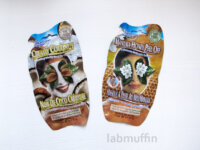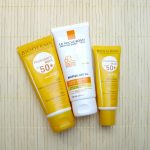Why do I need to exfoliate?
Your skin cells are constantly renewing themselves – your entire
epidermis (outer skin layers) is replaced every 50 days. Millions of dead skin cells
are shed each day from the topmost layer (the stratum corneum) in a natural process called desquamation.
However, many things can interfere with this process, such as ageing, hormonal fluctuations, dietary deficiencies and environmental changes – this can then lead to acne, clogged pores, rough patches, wrinkles, ingrown hairs, and dull, uneven skin. Helping the process along by exfoliating can restore clear, smooth, soft skin.
What exfoliants are available?
Exfoliants can be divided into two types: physical and chemical. Many exfoliants can be bought from the supermarket or department store; additionally, stronger exfoliating treatments can be performed by beauticians and dermatologists.
Physical or mechanical
Anything that is hard and basically scrapes dead skin off: polystyrene beads, plastic grains, crushed apricot kernels, rice bran, oatmeal, facecloths, loofahs, body brushs, razors, face brushes, even clothing. Microdermabrasion is an example of a physical exfoliation technique which can only be performed by a trained professional.
Many scrubs available on the market can be too coarse to be used on most people’s faces and end up causing more harm than good – Apricot Scrub is an example. Rounded synthetic beads are a much safer option – however, it’s possible that they end up disrupting marine life since polyethylene is generally not biodegradable and beads found in scrubs are too small to be filtered out, but only a very small amount is used. Scrubbing particles which are both environmentally friendly and skin-safe can be found in your kitchen – sugar, salt or baking soda (if your skin is resilient enough).
Scrubs are generally not recommended as the main exfoliating treatment for people with sensitive or irritated skin, and it’s very easy to overexfoliate with physical exfoliants simply by scrubbing too hard or too long.
Chemical
Usually a liquid, doesn’t require rubbing to work, contains chemicals which dissolve the “mortar” between the cellular “bricks” and encourage dead skin to lift off. They also sometimes break down the individual dead skin cells. The milder formulations often work best if left on, rather than used in scrubs or cleansers.
AHAs – lactic acid (mild), glycolic acid. Exfoliates surface of skin, may increase turnover/production of new cells. Good for dry and sun damaged skin, since they also have a humectant action.
BHAs – salicylic acid, very similar to AHAs but dissolves oily sebum plugs well, particularly good for acne-prone skin. Also has anti-inflammatory and antibacterial properties
Read more about the differences between AHAs and BHAs here.
Enzymes – certain enzymes have exfoliating properties, including papain (from papaya), bromelain (from pineapple) and keratinase (from bacteria). These have not been the subject of as much research.
Chemical peels – very strong chemicals peels are available from trained professionals. These may give excellent results, but also require recovery time; however, exfoliation is usually not the main desired effect. Some examples are TCA and phenol peels.
How often should I exfoliate?
Exfoliation is great, but it’s possible to exfoliate too much! It’s different for each person with each different product, so some experimentation is needed – if you overdo it, your skin will let you know, but usually not right away. One of the more common ways people tend to overexfoliate is by using a variety of products at once, then waking up the next day with a red, flaky and itchy face! Some dryness and irritation is common post-exfoliation – make sure you moisturise.
Some medications (e.g. acne medications) make your skin more prone to irritation, so it’s important to be cautious when starting a new exfoliating treatment. This goes for anything else that gives you irritated skin, like shaving or sunburn – you don’t want to exacerbate the damage!







one question, I know some say that cleansers don’t do much because you wash it off. Is that the same as salicylic acid facial wash?
Yes, basically! One of the benefits of salicylic acid is that since it’s fat-soluble, it can get into pores through the sebum plugs and essentially exfoliate inside the pore, but seeping through the gunk takes some time. The main problem with salicylic acid in cleansers/washes/scrubs is that they aren’t meant to be left on for longer than a few minutes (most cleansers are fine if they’re only in contact with the skin for a few minutes, but leaving them on for longer often leads to irritation) – it’s unlikely that a few minutes is long enough for the salicylic acid to really have an effect!
This is a great post! I use this silicon scrub I received with my L’oreal product, and use it with every thing else I have! It makes my skin feel so much cleaner!
As much as chemical exfoliants are supposed to be better for your skin, I also love the “clean” feeling rubbing something in gives! 🙂
Love starting the day by learning something new from your blog. 🙂
Thank you Alanna! xx
Hi, I love using peeling gels. It befuddles me how they work. hope you can do a post on that. Thanks!
It befuddles me too – I suspect it’s simpler than it makes itself out to be, but there could be something in them I’m not aware of, and it really doesn’t help that most of them have Asian-only ingredients lists and labels! Eventually I’ll work it out 😉
I thought baking soda wasn’t recommended for the skin due to it’s pH level. It damages the skin barrier, making it a bacterial breeding ground.
That’s a good idea for a post actually, thanks! Baking soda does have a highish pH (10 if saturated), but since it’s only in contact with your skin for a very short period of time, and skin has an excellent ability to restore its pH, it’s unlikely to cause enough damage to the skin barrier to make skin more of a bacterial breeding ground than it already is (skin is actually full of bacteria, and not all of it is bad – there’s evidence that it’s more of a digestive system-like balance of good and bad bacteria). There’s also some evidence that high pHs will actually assist in exfoliation. Of course, I’d recommend avoiding exfoliation and any drastic pH changes altogether for irritated skin!
So that said: can one use natural bar soap then? Why all the hype about pH of what you have said is true?
Check out this post: All About Cleansing & How to Choose a Gentle Cleanser. Bar soap is generally a bad idea!
Great blog! Been learning a lot about skincare from your site. May I suggest a post on the famous pitera SK-II facial treatment essence & Kose medicated Sekkisei Lotion? I’m wondering how pitera works & how come there’s mild exfoliation when I use Sekkisei, though there’s no acid in the ingredient list, just alcohol. I do hope to get a science view for this. More power to your site! I’m an avid fan. Thank you in advance.
Exfoliation provides many benefits to your skin. One of these is it makes the skin clearer by removing all the dead skin cells on it. It makes the skin soft too. That’s true that when you exfoliate, you should not exfoliate too much because it causes skin irritations and blemishes. Thanks for expanding out knowledge about this.